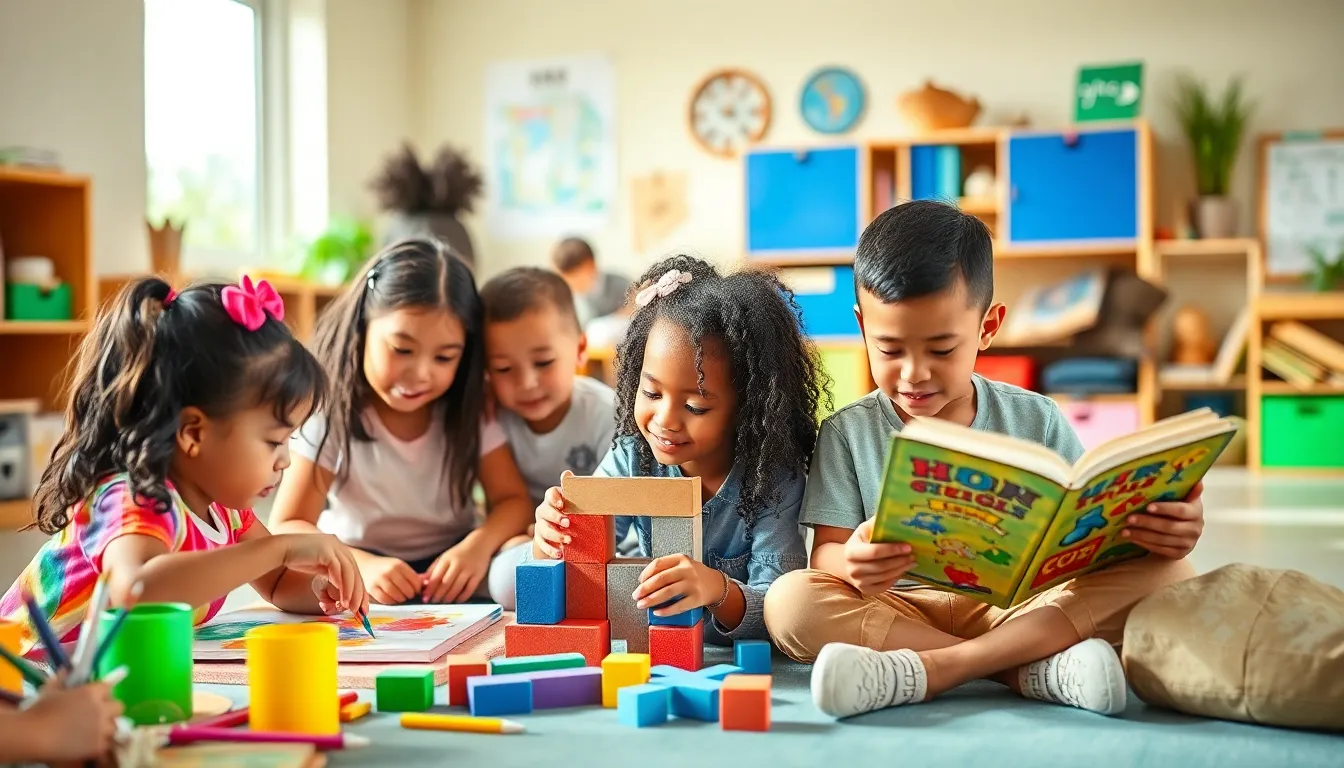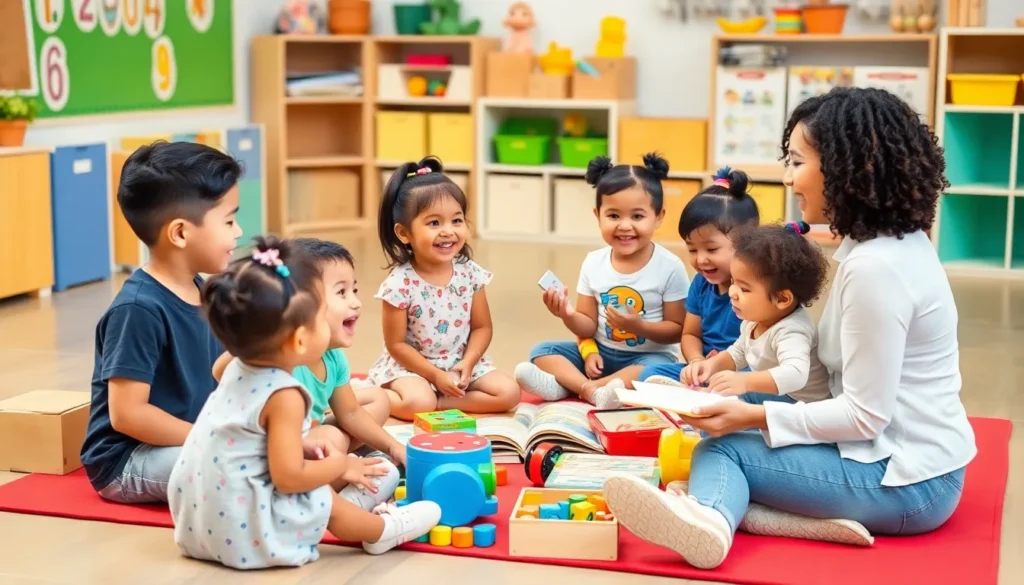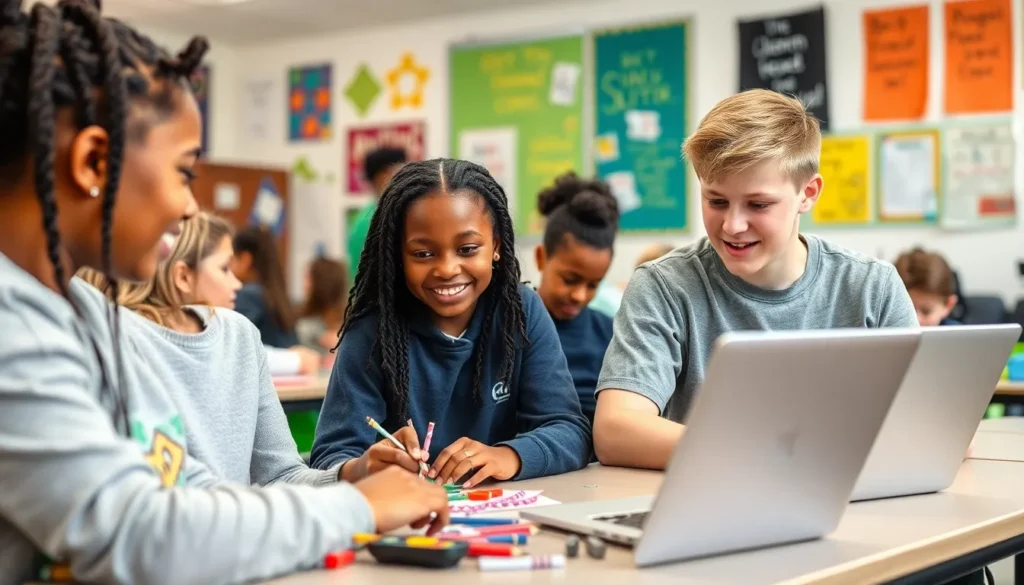Table of Contents
ToggleIn a world where traditional classrooms often feel more like prisons than places of learning, alternative education emerges as a breath of fresh air. It’s like swapping a stuffy suit for your favorite pair of sweatpants—comfortable and way more fun! This innovative approach to education breaks the mold, offering unique methods that cater to diverse learning styles and needs.
Forget the one-size-fits-all mentality; alternative education encourages creativity, critical thinking, and hands-on experiences. Whether it’s homeschooling, Montessori, or unschooling, these methods empower students to take charge of their learning journeys. So, if you’re tired of the same old lecture routine and ready to explore an educational landscape that’s as vibrant as a rainbow after a storm, buckle up! Alternative education might just be the ticket to a more engaging and fulfilling learning experience.
Understanding Alternative Education Meaning
Alternative education refers to educational practices that diverge from traditional methods in public or private schools. This approach caters to diverse learning needs and acknowledges that not all students thrive in conventional environments. Alternative education prioritizes personalized learning experiences, allowing students to work at their own pace and explore subjects that interest them.
Programs within alternative education vary widely. Homeschooling enables families to customize learning experiences tailored to each child’s needs. Montessori education emphasizes self-directed activity and hands-on learning, encouraging students to engage with materials at their own pace. Unschooling focuses on natural learning opportunities, allowing children to follow their interests and curiosities without the constraints of a set curriculum.
Many proponents argue that alternative education fosters essential skills. Creativity surfaces as students participate in projects that align with their passions. Critical thinking develops through real-world problem-solving activities. Additionally, hands-on experiences cultivate deeper comprehension and retention of knowledge.
The flexibility inherent in alternative education appeals to diverse learning styles. Educators and parents often seek out options to best support student engagement and achievement. This approach emphasizes the belief that education should cater to the individual rather than conforming to a one-size-fits-all model. Alternative education continues to gain traction among families looking for meaningful and impactful educational experiences.
The History of Alternative Education

Alternative education traces its roots back to the early 20th century, shaped by innovative thinkers and reformers.
Early Models of Alternative Education
Progressive education emerged in the late 1800s and early 1900s, largely influenced by educators like John Dewey and Maria Montessori. Dewey advocated experiential learning, emphasizing critical thinking over rote memorization. Montessori introduced child-centered learning, focusing on individual interests and natural development. These early models laid the groundwork for methods that prioritize personalized education, offering a departure from traditional systems.
Evolution Through the Decades
The 1960s and 1970s marked significant growth in alternative education, driven by social movements and a push for educational reform. Alternative schools emerged as responses to dissatisfaction with conventional educational structures. In the 1980s and 1990s, homeschooling gained popularity, supported by legal reforms that recognized parental rights in education. By the early 2000s, the internet played a crucial role in expanding access to alternative educational resources, fostering diverse learning communities. Over these decades, alternative education has continued to evolve, adapting to changing societal needs while emphasizing creativity and individualized approaches.
Types of Alternative Education
Alternative education encompasses various methods that cater to diverse learning needs. Here are some prominent types.
Montessori Education
Montessori education emphasizes child-led learning. Students engage in hands-on activities that promote independence and critical thinking. Age-mixed classrooms foster collaboration among different age groups. Teachers guide rather than instruct, providing resources tailored to each child’s interests. This approach encourages exploration, allowing students to learn at their own pace. Evidence shows that Montessori methods can lead to improved academic and social skills.
Waldorf Education
Waldorf education focuses on holistic development through an integrated curriculum. It nurtures creativity, critical thinking, and emotional intelligence. Emphasis on arts, music, and practical skills distinguishes this approach. Classes typically combine storytelling, movement, and hands-on work. Teachers often stay with the same class for multiple years, building strong relationships. Research indicates that Waldorf students excel in creative problem-solving and social cohesion.
Charter Schools
Charter schools operate independently from traditional public schools. They emphasize educational innovation and flexibility. Often designed around specific themes, such as the arts or science, these schools attract diverse groups of students. Accountability for performance ensures that schools meet specific educational outcomes. Parents often appreciate the choice charter schools provide within the public education system. Data reveals that charter school students frequently achieve performance gains compared to their peers in conventional schools.
Benefits of Alternative Education
Alternative education offers numerous advantages that enhance student learning and development. Two significant benefits include personalized learning experiences and the encouragement of creativity.
Personalized Learning Experience
Personalized learning experiences allow students to progress at their own pace. They can explore subjects that spark their interest in depth. Customization of learning environments caters to different styles, making education more effective. Students often engage more deeply with material tailored to their preferences. With greater autonomy, learners develop skills that align with their unique talents and aspirations. This approach fosters self-motivation and a lifelong love for learning. In alternative education settings, adjustments to curriculum frequently happen based on student needs and feedback, creating responsive educational journeys.
Encouragement of Creativity
Encouragement of creativity is an essential aspect of alternative education. Students frequently participate in hands-on projects that inspire innovative thinking. This type of environment nurtures imagination and allows for trial-and-error learning. Themes such as art, music, and science often intertwine, providing opportunities for interdisciplinary exploration. Creative problem-solving takes center stage, as students tackle real-world challenges through imaginative approaches. In alternative settings, learners receive the freedom to express themselves without traditional constraints, leading to higher levels of engagement and passion for their work. This dynamic fosters an atmosphere where creative minds thrive.
Challenges Faced by Alternative Education
Alternative education encounters several significant challenges that can impact its effectiveness and accessibility.
Funding and Resources
Funding remains a primary obstacle for many alternative education programs. Limited financial support restricts access to resources, materials, and qualified educators. Schools often rely on tuition and donations, making sustainability difficult. Various alternative education models may not receive adequate government funding, leading to disparities in quality. Families frequently invest their own money for educational materials, creating inequities. Managing budgets effectively becomes crucial; otherwise, programs may struggle to maintain operations. Those interested in alternative education face varying costs that can deter participation, especially in lower-income areas.
Public Perception
Public perception significantly influences the growth and acceptance of alternative education. Many individuals associate alternative education with being less rigorous than traditional systems, creating skepticism about its validity. Misconceptions about these educational models often lead to stigmas that dissuade families from exploring options. Educators in alternative settings work diligently to demonstrate the effectiveness of their approaches yet encounter resistance. Engaging the community through outreach programs helps shift perspectives on the value of alternative education. Positive experiences must be highlighted to enhance credibility, showcasing that diverse methods can yield successful student outcomes.
Alternative education offers a refreshing approach to learning that prioritizes individual needs and fosters creativity. By embracing diverse methods like Montessori and homeschooling, students can thrive in environments tailored to their unique learning styles.
This innovative educational landscape not only encourages critical thinking but also nurtures a lifelong passion for learning. As more families explore these options, the conversation around alternative education continues to grow, challenging traditional views and highlighting the importance of personalized experiences.
Ultimately, alternative education represents a shift towards a more inclusive and dynamic understanding of what learning can be, paving the way for future generations to flourish.




